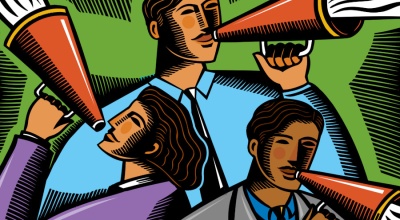In the early 20th century, black intellectual W.E.B. Du Bois issued a call for voluntary financial cooperation among blacks oppressed by racism and segregation, echoed in 1966 by the A. Philip Randolph Institute’s “Freedom Budget for All Americans” designed to stamp out poverty in America.
The Freedman's Savings Bank Good Intentions Were Not Enough, a Noble Experiment Goes Awry
The bank, while successful in its early days, ran afoul of corruption and mismanagement before it was shut down for good, but not without some lasting benefit. The bank held up to $57 million across several states including Washington, D.C. and large deposits. Most African American accounts were small but significant, for the short time being freed from slavery.
The all-white board of trustees shut down the bank due to mismanagement of funds. Frederick Douglass used $10,000 of his money to keep the bank in operation and became its president. But the bank’s troubles were too much to overcome and Douglass recommended to Congress it shutter its doors. African American had its first experience of savings lost to the white men corruption and disapproval of the Reconstruction.
"One cannot study Reconstruction without first frankly facing the facts of universal lying."
W.E.B. DuBois
Video: Discover Your Roots Using the Freedmen's Bureau Records
The End of Slavery and the Birth of the Freedman’s Bank
With the passage of the 13th Amendment and the end of the Civil War in 1865, slavery was finally abolished in the United States. The practice had existed on the American continent for more than 200 years.
Almost overnight, nearly 4 million African American men, women, and children were free. With the South in ruins, they faced disorder and danger. Most had no home, no money, and no work. Their relatives were scattered all over the country and nearly impossible to find.
To address the needs of the newly freed slaves, the U.S. government created the Bureau of Refugees, Freedmen, and Abandoned Lands. Commonly known as “the Freedmen’s Bureau,” it provided food, housing, and medical aid to tens of thousands of freed slaves. It located relatives and reunited families, and it helped to establish schools all across the South for African Americans.
Meanwhile, a group of missionaries, abolitionists, and businessmen saw that African Americans would need support and education to become financially secure. The group worked to create a savings bank for former slaves, African American veterans, and their families. In 1865, they succeeded. The Freedman’s Savings and Trust Company, often called “the Freedman’s Bank,” opened for business.
The Freedman's Savings and Trust Company and African American Genealogical Research
The Life of Freedman's Bank
The Demise of Freedman's Bank
The Lasting Impact of Freedman's Bank
The Financial Panic of 1873
Freedman's Bank and Family Histories
Freedman's Bank Building | U.S. Department of the Treasury
On January 7, 2016, Treasury Secretary Jacob Lew renamed the "Treasury Annex," the Freedman's Bank Building. The Treasury Annex, was erected on the original site of the Freedman's Bank Building in Washington, DC. As such, Secretary Lew thought it fitting to rename the Treasury Building after the sesquicentennial of the founding of the Bank.
The Freedman's Savings and Trust Company was a private corporation chartered by an act of the U.S. Government signed in 1865 by President Abraham Lincoln. It was created to help develop the newly freed African Americans as they endeavored to become financially stable. Originally, the bank was headquartered in New York, but later moved to Washington, DC. Eventually, there were 37 locations across 17 states.
After a year of research commencing in 2015, the Cleveland Federal Reserve Bank created and launched a series of panels, regarding the Freedman's Bank in 2016. This was done largely to celebrate the sesquicentennial of the bank's charter year of 1865. In the 1860s, there was little opportunity for African Americans to amass enough wealth to bank. There is a connection today in that there is still a large population of people of color that are the unbaked for various reasons. It was important for the Cleveland Federal Reserve Bank to showcase the success (albeit temporary) of the Freedman's bank and the amount of wealth freed slaves contributed to the economy.
Treasury acknowledges the generosity of the CFRB in sharing the online exhibit regarding the Freedman's Bank Building.
Information and Resources
Video: About the Term Freedman
The Archives holds a wealth of material documenting the African American experience, and highlights these resources online, in programs, and through traditional and social media.
Discovering the Civil War Special Exhibit
In the National Archives'-produced video short "Discovering the Civil War" the creators of this exhibition share little-known facts and extraordinary discoveries found in the incomparable Civil War holdings at the National Archives. These stories are for the first time in this exhibition, the most extensive display ever assembled from these records. The video also features rarely-seen original footage from Civil War reunions in 1917 in Vicksburg, MS, and 1938 in Gettysburg, PA.
There is a companion online preview exhibit – Discovering the Civil War. Especially useful if you won’t be able to see the exhibit in DC or truly want to get a preview of what you will be seeing.
The spring edition of Prologue focused on the Civil War. Prologue magazine brings readers stories based on the rich holdings and programs of the National Archives across the nation—from Washington, DC, to the regional archives and the Presidential libraries.
Prologue on the Civil War: Special Issues
Prologue magazine brings readers stories based on the rich holdings and programs of the National Archives across the nation—from Washington, DC, to the regional archives and the Presidential libraries. Access many of articles online.
Prologue was published quarterly by the National Archives and Records Administration (NARA) for nearly 50 years. The Winter 2017–18 issue was the last printed edition.
Public Downloads
All items are free to view, share, and download.
Public Downloads - Español (Spanish)
When available, we provide all our content with a Spanish version in our public download section. You can find added material from sources listed in all our articles.
Download Freedman's Educational Activities














